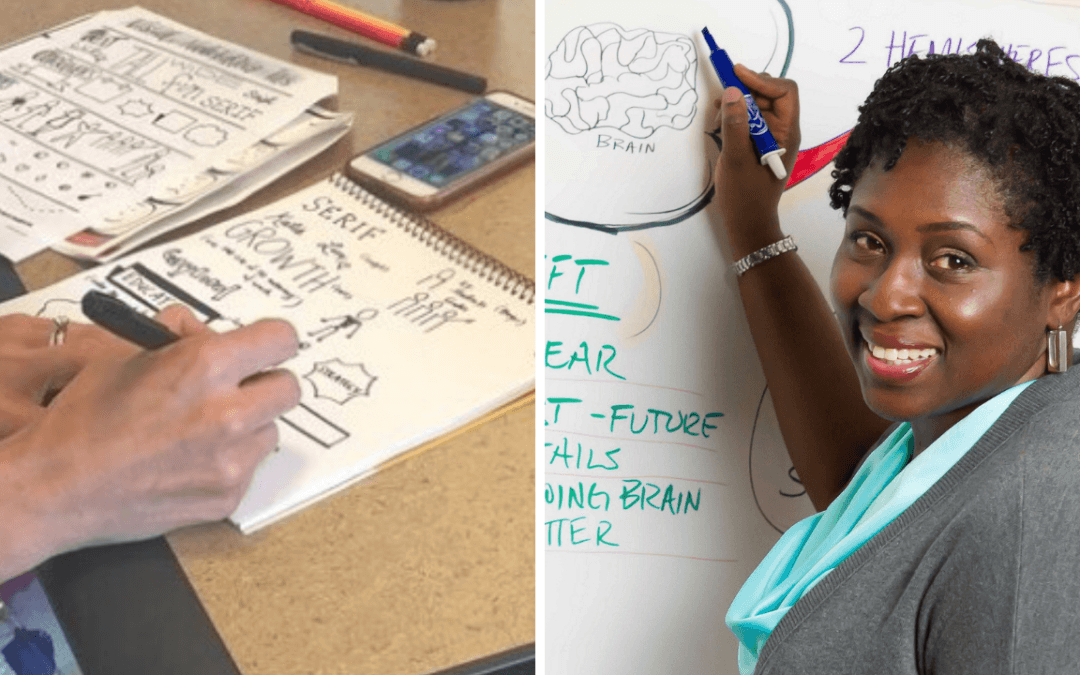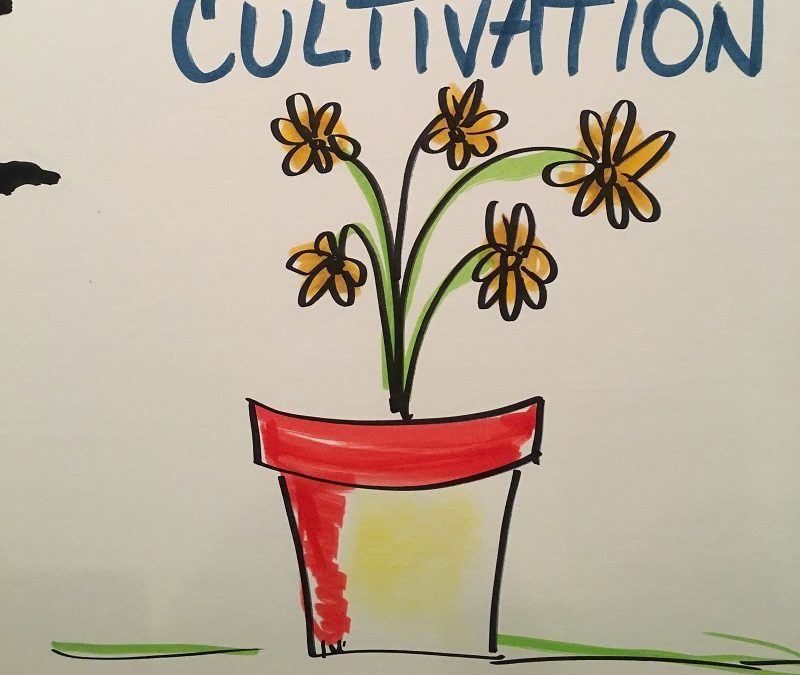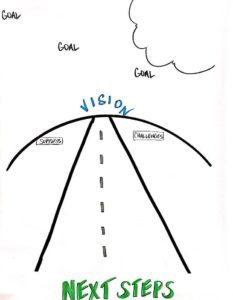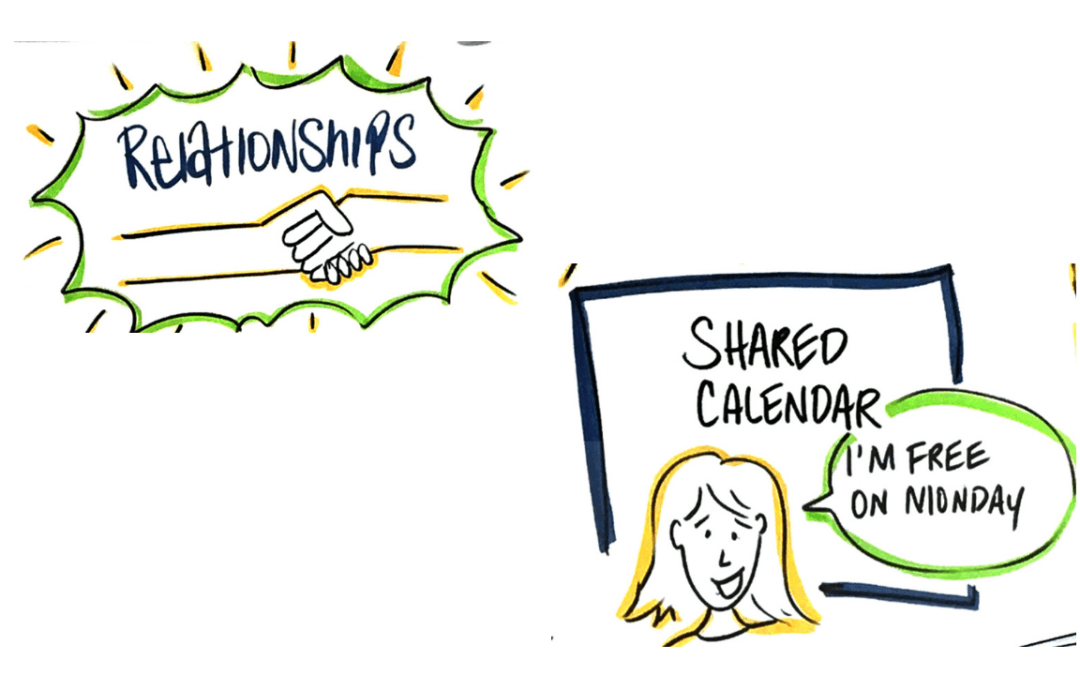
by Lisa | May 1, 2019 | Event Planning, Facilitation, Graphic Recording, Visual Thinking
Annual meetings are a time of brainstorming, collaborative thinking and intensive informational exchange. Participants can feel a sense of burnout at various parts of the process, so keeping them engaged is crucial. Utilizing a service like a visual facilitator can provide unique imagery and perspective. Use this unique visual storytelling for a time of reflection. You can strengthen your agenda and keep your team energized and open the pathways to learning.

Here are some ideas for using reflection for meaningful discussions and recall. These reflections can be captured by a graphic recorder as well!
- Previous Year Reflections: Allow each member around the room to highlight what worked well and lessons learned from the past year. You could also suggest that they collaborate with their department for their contributions to the discussion.
- Internal Reflections: Prompt participants with the question, “What have you learned about yourself so far?” before lunch or scheduled break in your meeting. Give your team a heads up that you will be asking this question during the session so they don’t feel “on the spot.”
- Silent Reflections: Set a timer for 5-10 minutes for a period of silent reflection. Calming background music is also a great addition to this part. While the silence may feel a little odd at first, it will provide time for those in the room to reset of their mind. At the end of the timer ask if anyone would like to volunteer a thought or two from their “meditation.”
Let the group think back to what they learned throughout the meeting and share their takeaways. Give time for the graphic recorder to illustrate each members thoughts. At the end, you can decide collectively how to share these visual notes. Are you facilitating an annual meeting? Breakout sessions? Let our team help with the visuals! See our portfolio and learn more here!

by Lisa | Apr 17, 2019 | Business, Graphic Recording
In this post, I am going to answer some questions that I get pretty frequently about graphic recording. From what is it to why I love doing it – I am breaking it down for you. Here are the answers to the most common questions that I get asked!

Question #1 “What’s the name of the thing you are doing?”
Most times I get asked by participants at events when I am working. I share with them that I am doing graphic recording. They have usually never heard of it before, so it is fun to share with them about the technique. Want to learn more about this? Check out this video that shares more!
Question #2 “How did you find out about this?”
I found out about graphic recording through a video on YouTube. Yes….Youtube! I was browsing videos about beauty, style and natural hair and I stumbled on a video where someone used doodles to explain the process. In the video, a woman took out a large piece of paper and started drawing. She shared that her sketches were actually called graphic recording. She talked about her business and how people hire her to listen and draw at their meetings or events! I thought to myself “you mean this is a thing, a job!” I got hooked and did some more research and later got trained in this method. From there, I gained the skills, helped clients, built a team and grew the business I have today.
Question #3 “What kind of markers are those?”
The markers that I use are very distinct and have a pretty unique look compared to your typical marker. The company that I use is called Neuland. They are based in Germany. Their products are really durable and the markers are refillable (an eco-friendly plus!). I love how vibrant the colors are. They are great quality and certainly my favorite.
Question #4 “Did they give you any information ahead of time before this session?”
Sometimes when I am hired to record an event, meeting or panel, I am provided with an outline or powerpoint of what will be covered. However, the majority of the time I don’t know what is going to be shared in a session. Event organizers don’t always have the speaker finalized or the speaker may even change up their presentation right before. Part of the job as a graphic recorder is being in the moment and listen to what is being said. While having pre-prepared materials is nice, we can not always depend on that going into an event.
Question #5 “What happens if you make a mistake?”
This is a great question! There are certainly ways to put a band-aid over your “boo-boo’s” if mishaps occur! I always keep a few white mailing labels in my kit to cover up any mistakes and keep going. I also use white-out depending on the size of the mistake. These two little tricks of the trade have helped me out over of the years!
Question #6 “Were you always an artist?”
No, not really. I have always loved art and appreciated it. However, I have never been formally trained. My father had beautiful handwriting and taught me how to write in script. He planted the seed and I never realized it until I learned about graphic recording. His script style has certainly been incorporated into my work. Lettering is a huge part of graphic recording and it is considered art as well. My background is in IT and management so I did not go to school for art specifically – but my education is a great tool for my work. I am able to mix my love of art with communication and business. Make no mistake, graphic recording and facilitation is hard work but it’s “heart work” and I love it!
Got questions? Check out our FAQ page or contact me here!

by Lisa | Apr 3, 2019 | Graphic Recording
Making time for a self-audit of your schedule, daily habits, free time activities, etc. is a great exercise to complete every quarter. This time of review not only opens up new ideas and goals, but it is a great learning experience. You can use this time to reflect on all sorts of things that you encountered during a three month period. The best part is that you can use visual thinking to do it.

To complete a visual self-audit of your schedule, we recommend gathering a few supplies first!
Things you will need:
- Your calendar: digital or paper planner
- Poster Board or large sheets of paper: to draw out your audit
- Markers or colored pencils: to incorporate color into your audit
After you gather your materials, take time to flip through your schedule and check out your phone to review what types of things occurred over the past few months. Write down the projects you completed, the trips you took, the time you invested in your health or self-care. Whatever stands out to you, write it down. Incorporate your sketchnote skills also to illustrate specific events. Get creative!
Now for the auditing process. Get a red, green and blue marker from your materials. These will be used to circle various parts of your visual audit — memories or events that were positive, circle or highlight with green. For negative experiences, mark them with red. Areas that you see improvement or potential growth opportunities use blue to distinguish this item.
This process should be based on gut reactions. Do not overthink this part! Once you have categorized each item with your color code, take a step back and review your completed audit.
What color is the most dominant? If you are unhappy with your dominant color, what steps can you take to change your dominant color this next quarter?
Keep this process into practice throughout your year. Take photos of your posters or scan them to reference over time. See your evolution of growth and progress!
Want some tips for drawing easy visuals? Sign up for our Visual Notetaking Tip Sheet!

by Lisa | Mar 20, 2019 | Graphic Recording
Visual thinking can add some creativity and spark to your work in ways that you could not have imagined! If you are facing a slump or feel like you’re in a rut, we have some ideas on how visual thinking can be incorporated into your workplace and help turn things around!

Start goal setting – Use graphic recording to get a group thinking about vision, goals and next steps. Ask them what are the challenges they see, and what are the supports? Sketch their ideas on a flip chart or large sheet to display in the office.

Display motivational quotes – Everyone needs a little bit of encouragement from time to time and creating a fun visual to share is a great way to spread some motivation! Have co-workers submit their favorite quote or mantra to be designed and displayed using sketchnotes. Put the finished product in places they would least expect like inside a storage cabinet or behind a door in the breakroom to give a fun surprise when they discover it.
Ease stress – Zentangle is a great way to doodle while you get your mind off the pressure. It is proven to help you relax too. Ease that tension in your shoulders with a short break of drawing circles, waves, and spirals. It doesn’t matter what kind of pattern. After a few minutes, you will find your mind refreshed and ready to go.

Strategize next steps – Gather the team to create a visual timeline of what is to come in the company. This can be a helpful resource and reference point for your coworkers. Your visual recordings can provide an outline, but also a unique way to cross off project benchmarks. When major items are completed, allow for a different team member to draw something that represents a finished step or next move. Engage everyone with a participation piece to the timeline.
Do you feel inspired yet? Check out more ideas on our portfolio through our website!

by Lisa | Mar 6, 2019 | Event Planning
When planning for a conference, event or meeting, See is Colors is excited to help bring your company’s vision to life! We have a refined process and workflow that helps set you up for success! We think of it all, so you don’t have to. We want to be the easiest to-do you can cross off of your event prep list.

Below you will see a breakdown of our workflow to help you understand our event/conference work process! It is pretty simple and straightforward, but we want you to feel confident in our services and ready for all of the fun that is in store with sketchnotes.
Part of our process includes an initial meeting with you. We talk about your objectives for your upcoming event along with a timeframe. We review details such as venue, date and time, etc. Through this consultation, we will talk about the creative and fun elements included in our services. We share about our different styles of sketchnoting and present a few recommendations about what we think will work best for your event.
No matter how big or small of a gathering, we have an idea in mind for you. Each event is so unique, and we want to offer you one of a kind of experience that your participants will get excited to experience. We also take some time to talk about your goals for your conference. We want to help you achieve these targets and can’t wait to work together to make it happen!
Once we determine things are a good fit, we will send over a quote and overview of services. If you have any additional questions, we address them during this phase. Once approved, an official agreement will be signed. After the t’s are crossed, and the i’s are dotted, we’ve got things covered from here!
We will share our supply list to let you know that we will be prepared and ready to roll on the event day. We take care of everything – ordering the paper, purchasing the markers and making sure that the ink is flowing. We always make sure to pack a large roll of paper. We like to think that big paper creates big ideas!
Ready to get started? Check out more about our services here!












